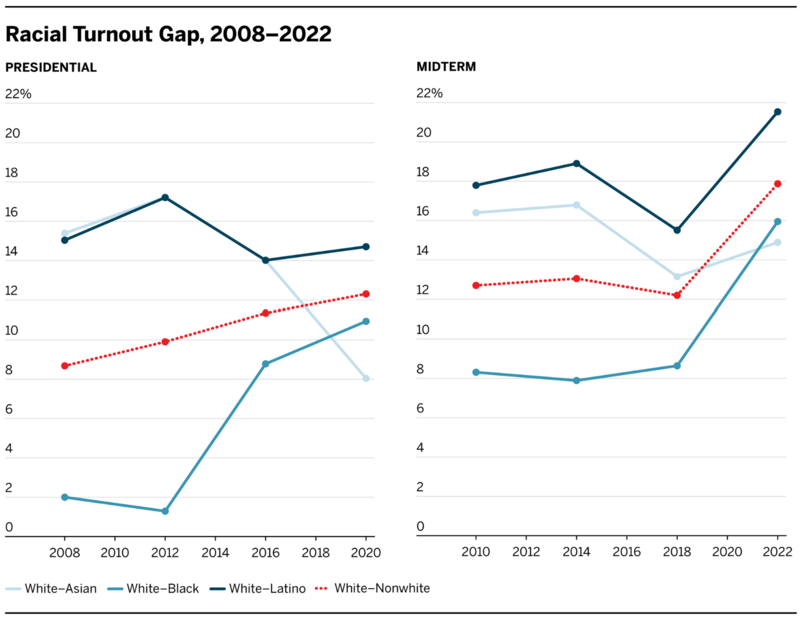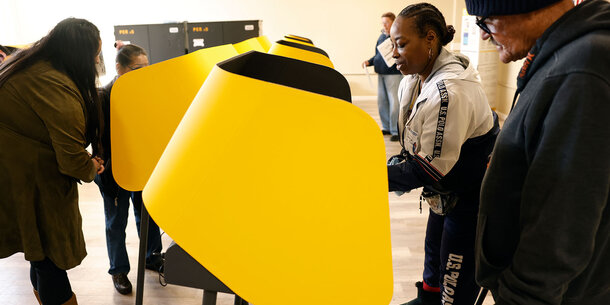In 2013, 50 years after the March on Washington, Rep. John Lewis stood on the steps of the Lincoln Memorial and pointed to a “renewed struggle for voting rights.” A decade later, nearly 100 laws making voting more difficult have been enacted in 29 states, and the racial turnout gap between levels of white and nonwhite voting rates reached a modern high. This disturbing trend signals the continued saliency of the civil rights leader’s words.
The gap was largest for Latinos, whose turnout lagged 22 percentage points behind the rate of white voters in 2022. While the gap in 2022 was also large for Black voters, at 16 percentage points and 15 for Asian voters, the size of the eligible voting population of Latinos represents a huge number of missing potential votes. If the turnout rates had been equal with white voters in 2022, Latino voters would have cast over 6.6 million more ballots.
In a new Brennan Center report, we analyzed the nearly 1 billion votes cast in federal general elections since 2008. Over that entire period, nonwhite turnout has been considerably lower than white turnout.
That Latinos — the most populous minority group in the country — have the largest turnout gap is especially troubling, and lawmakers and voting rights advocates alike must work together to address the disparities and make voting more accessible. We found that the gap has steadily grown in the post-Obama era, even in the face of record high turnout overall. While the gap in presidential elections has held steady for Latinos, it was much larger in the 2022 midterm elections than it was historically. In fact, it was more than a third higher in 2022 than in 2010.

The turnout gap has a big impact on statewide turnout rates, which were pushed down by the gap most in states where Latinos make up the largest nonwhite group.
For instance, in the 2022 election, Latinos made up the largest nonwhite group in each of the six states where the gap depressed statewide turnout the most. Turnout in Florida, New Mexico, and Texas would have been more than 8 points higher in 2022 if the racial turnout gap had closed.
One driver of this growth in the turnout gap was the Supreme Court’s decision in Shelby County v. Holder to severely weaken the 1965 Voting Rights Act and the numerous state voter suppression laws that followed. The narrow majority’s decision in 2013 suspended Section 5 of the monumental civil rights legislation, which required jurisdictions with a history of racially discriminatory election laws to receive federal approval before enacting any new election practices.
Since then, lawmakers in the states formerly covered by Section 5 have enacted nearly 30 laws making voting more difficult. We find that the white–nonwhite turnout gap has grown far more quickly in counties that were formerly covered by Section 5 than elsewhere. And, past research has demonstrated that restrictive voting laws — like those that target voters with language access barriers or establish strict voter identification requirements — can have unique disenfranchising effects on Latinos.
The effect of the decision was especially large in counties that tried to implement racially discriminatory policies that were blocked by Section 5 prior to Shelby County.
It’s important to note that Shelby County cannot fully explain the nationwide growth of the turnout gap. As we discussed above, the turnout gap has also grown substantially in regions not formerly covered by Section 5.
The troubling trends in the racial turnout gap and the role of Shelby County illustrated in our report should serve as a clarion call to Congress, scholars, and activists alike: it has never been more urgent to heed Lewis’s words and pass the John R. Lewis Voting Rights Advancement Act. The landmark bill would strengthen the Voting Rights Act, protecting voters of color from discriminatory election practices and ensuring that everyone can fairly participate in American democracy.
A version of this article was originally published in Spanish by La Opinión.





